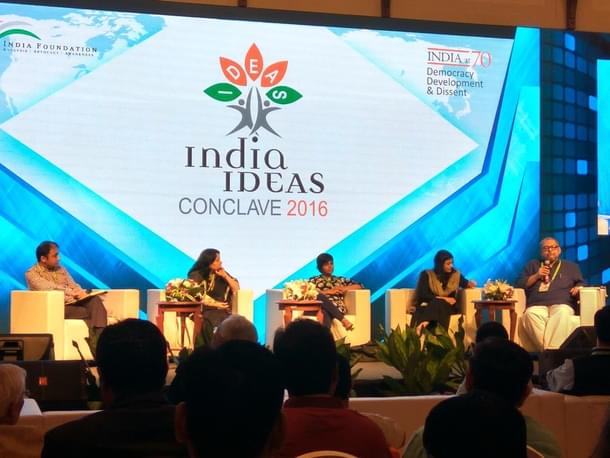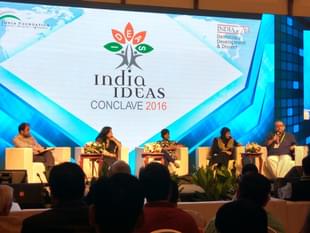Politics
Putting The Mainstream Media On Notice: The Time For ‘Good’ Dissent And ‘Bad’ Dissent Is Over
Rajeev Srinivasan
Nov 07, 2016, 06:13 PM | Updated 06:13 PM IST
Save & read from anywhere!
Bookmark stories for easy access on any device or the Swarajya app.


I write this after having spent an invigorating three days at the India Ideas Conclave 2016 in Goa, where I was kindly invited to be a delegate by the India Foundation. The theme was India at 70: Democracy, Development and Dissent. As expected, the sessions were very good, and it offered a chance to renew old acquaintances and make new friends.
There were several highlights: one was meeting the amazing Temsutula Imsong, who has made it her sacred mission to clean up Varanasi’s ghats, another the session on foreign affairs, a third the brief benediction by video by His Holiness the Dalai Lama.
But the most raucous session was the one on dissent, which ended up being, to a significant extent, a critique on media. I have attended a number of meetings of nationalists in the past decade, and a consistent theme has been the lack of space for our voices in the mainstream media and discourse. Of course, this is a worldwide phenomenon. It has not improved noticeably in the time the Bharatiya Janata Party has been in power, and except for a few outlets like Swarajya, Rediff.com and Pioneer, the standard left narrative continues to dominate, in often destructive ways.
The entire idea of ‘dissent’ has been perverted to an amazing extent by the leftists, so that the discourse is extraordinarily skewed to the left. I have long observed that what is considered ‘centrist’ in India would be considered ‘far left’ in most other countries, and a real ‘centrist’ would be deemed ‘far right’. The Indian discourse consists of the ‘lunatic fringe left’, ‘extreme left’ and ‘left’. Such a distortion has created a narrative that is destructive, untrue and unsustainable.
‘Dissent’ has been defined in terms of a straw man, which boils down to a severely demonised Hinduism. According to this narrative, everything that’s wrong with India can be attributed to Hindu ideas, and until Hinduism is wiped out, there is no hope for India. A dharma-free India should be the goal of all ‘progressive’ people. This, you might notice, is essentially the Nehruvian belief, and it was also the colonial-missionary belief, as documented in Suhash Chakravarty’s brilliant The Raj Syndrome.
So, if you are an embattled Hindu, or even an atheist Indian, you feel there is an entire constellation of powers with a deeply negative intent arrayed against you, and that they have created a galaxy of sepoys, especially in media and academia, to use Rajiv Malhotra’s phrase from Breaking India.
According to them, there is ‘good’ dissent and ‘bad’ dissent, reminiscent of Robin Raphel’s immortal distinction between the ‘good’ Taliban and the ‘bad’ Taliban. ‘Good’ dissent is when the dominant left attacks every thing Indic. ‘Bad’ dissent is when Indics respond in kind: oh, but that is fascism, as pointed out in another session. Your dissent must be respected, but my dissent must be banned.
And there are many benefits to those who toe the line. In a short period of time, it has come to pass that top journalists get immensely rich, become members of Parliament, act as go-betweens and determine cabinet-level appointments (recall the Radia tapes). It appears that there is a quid pro quo, and as the saying goes, power corrupts.
It is in this context that the session on ‘dissent’ was so explosive. Chaired by Swapan Dasgupta (Rajya Sabha MP), it had as other panellists Roopa Ganguly (Rajya Sabha MP), Shekhar Gupta (editor-in-chief, The Print), Ashok Malik (columnist), Vivek Agnihotri (Filmmaker) and Aatish Taseer (columnist).
Aatish Taseer represented the traditional Lutyens elite, as the son of columnist Tavleen Singh, who was present in the previous edition of the Conclave. The traditional media elites, with their Oxford accents, have a vaguely international outlook, and tend to look at India through an American or British lens, with general distaste.
Shekhar Gupta is the epitome of the mainstream Indian media man. In the past, there was the infamous trip to Pakistan where he seemed to promise Musharraf that the Vajpayee regime would soon collapse. Later, when a series of bombs in Mumbai trains killed many, he seemed to downplay it because it was first class passengers, just a bunch of traders. He presented the mainstream view, with the signature meme of worrying about the human rights of the eight SIMI escapees who were gunned down after murdering a jailer.
It was a dramatic contrast to these two to hear Vivek Agnihotri, the filmmaker famous for his expose of urban-guerilla sympathizers of Naxalite movements, Buddha in a Traffic Jam. He thundered, literally, about how none of the alleged mavens of Freedom of Expression in the mainstream media came to his aid when he was assaulted and his car damaged by student goons. So Vivek does not have the right to dissent from the prevailing dogma? His pointed questions would have made any media bigwig squirm.
This was followed by a presentation by Arnab Goswami. He, too, pointed out that there is a cabal of Lutyens individuals who monopolize opinion-making in India: in fact, it is the very same handful of people who are considered ‘experts’ in every topic under the sun. And they brook no dissent at all. Goswami recounted an interaction with the previous PM (“he actually spoke”, said he, with mock horror). Out of 16 editorial interlocutors, he said he was the only one who didn’t lob a softball.
Warming up to his theme, Goswami then swore that his new project would be to wrench control of the opinion making away from the confines of Lutyens: which is why he himself moved to Mumbai in his earlier stint. He didn’t specify how, but he implied that he would create a technology based mechanism to create a truly global Indian medium, which would also not be confined to the TV interface (a digital medium?). There were roars of applause.
Other speakers also spoke about the rise of Social Media. The democratisation of social media the Lutyens crowd cannot deal with, as Kanchan Gupta pointed out in another session regarding the unfortunate Chaitanya Kunte who was hounded off social media with the threat of legal action for merely exercising his freedom of expression. Since a number of the young writers at the conclave cut their teeth on social media, this got much applause.
Goswami and Agnihotri were raising an open challenge to the status quo. Perhaps finally an Indian medium that represents the Indian point of view is viable. In the geopolitical game, all players have massive propaganda outlets: the US has its (CNN, VoA etc), the UK has the BBC, China has a plethora (Asia Times, Xinhua), Russia has RT, and the Arabs have Al Jazeera. India and Japan, both diffident, are the only major powers that are not putting forward their perspectives forcefully. We need one too (are you listening, Surya Prakash?).
The internet has been a great leveller and disintermediator. Twenty years ago, when Varsha Bhosle and I began our unabashedly nationalist columns on rediff.com, there were only a handful of other voices on the same page: Arvind Lavakare, Kanchan Gupta, T V R Shenoy, for instance. We’ve come a long way since then, baby! Now there are enough smart young writers: it is not the intelligence or content any more that is the problem, it is the distribution channel. Let the mainstream media beware: their days are numbered, if enough money and energy can be put into creating such a channel.
Rajeev Srinivasan focuses on strategy and innovation, which he worked on at Bell Labs and in Silicon Valley. He has taught innovation at several IIMs. An IIT Madras and Stanford Business School grad, he has also been a conservative columnist for twenty years.





